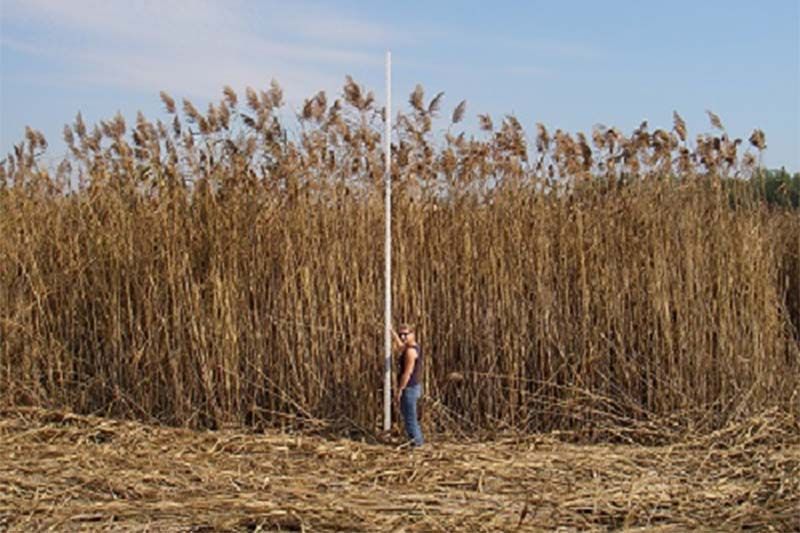Gray Merriam | May 31, 2017
Phragmites (say 'frag-might-ees') or European Common Reed is that huge plant with the flag of seeds on top that you are seeing more and more along roads in our area. It was probably imported from Eurasia mid-1800's in straw packing materials and first seen growing in Canada in Nova Scotia in 1910. For about 40 years it was unremarkable. But lately its spread is truly remarkable. It is so common in southern Ontario that locals call it simply "phrag". Predictions are that the great marsh (over 3000 hectares or 7500 acres) at Long Point on Lake Erie will be completely taken over by Phragmites in about five years.
Elimination of a marsh by phrag happens because the reed grows so densely and its stalks are so sturdy that animals such as turtles can't push through it. The roots deposit toxins in the soil (allelopathic), preventing growth of native plants and the dense reed growth shades out any that try to grow there.
Phrag spreads by underground rhizomes and surface runners as well as windblown seed. The most important mechanism of spread is by road construction and maintenance machines. Pieces of rhizomes and runners are carried on machines and in soil that is moved take root to start new colonies.
As with many other invasives, we gave phrag little attention when it first showed up. But when it produces larger colonies, as in the Long Point marsh, the citizens soon want "government to get on board". Locally, Central Frontenac has several small colonies. One is slowly expanding in the southwest corner of the Frontenac Road and Highway 7. Further east, there is a much larger colony behind the Smoke Shop on the south side of Highway 7 at Silver Lake.
Phragmites is largely absent from North Frontenac but there is a small 'starter' colony along the Ardoch Road in front of the North of Seven. There is another larger patch just over the boundary into Central Frontenac. This could be the source of seeds and rhizomes to spread phrag into North Frontenac. But we could stop that process by removing these small colonies before they can start that invasion. Just mowing won't do it! Information on control is available at the link cited below.
Small colonies escape detection at first because we don't recognize the plant, we don't know how damaging it will be when invasion progresses, and we don't recognize that these small starter colonies will be the source of stock to allow Phragmites to expand until it is damaging. Then, when phrag has captured all our roadsides and also our wetlands, we ask for control and, at that stage, it is unbelievably expensive.
The best control method is prevention of early establishment. The only control method that has worked consistently after colonies are established is spraying with Roundup and soy oil. Spraying must be certified under applicable municipal, provincial and federal regulations. It is unsafe to assume complete elimination after spraying because transported seeds, rhizomes and runners that are not killed by the herbicide can start new colonies. Following established best practices, the residue of tons of stems and seed can be burned off with preparation, care and approval.
Much tax money can be saved by early detection and elimination of invading Phragmites when it still has only small colonies. To report locations of colonies, contact local municipalities and call 1-800-563-7711 or go online to www.invadingspecies.com or call Friends of the Salmon River (613 379 5958) or Friends of the Napanee (613 377 1287) or your local Conservation Authority.
More information: https://dr6j45jk9xcmk.cloudfront.net/documents/2675/stdprod-089643.pdf
More Stories
- Province clarifies stance - Says Private Well Water Testing Will Continue
- Frontenac County Stays Internal for CAO - Appoints Kevin Farrell
- Addington Highlands Tax Bill Going Up 6.93%
- Perth Road United Church Donation to The Grace Centre
- 21 Years Of Dump Life Left At South Frontenac Waste Site
- Eclipse 2024 – Once In A Lifetime
- National Tourism Week
- NeLL Spring Open House and Anniversary Concert
- 25 years at Bishop Lake Outdoor Centre
- Grounds Contracts Down, Custodial Contracts Up In Central Frontenac

